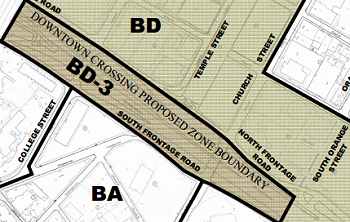The City of New Haven’s plan to replace the Route 34 stub highway with mixed-use urban development took a big step forward last week, after the Board of Aldermen unanimously approved zoning changes and a land disposition agreement that will allow Phase 1 of the Downtown Crossing project to move forward. But local citizens and advocacy groups have increasingly turned against the plan, saying the city’s planned changes to the street network will not do enough to make the area safe for walking and cycling. The city needs to commit to a more transformational second phase of the project to fully realize the promise of Downtown Crossing and win back residents.

Citizens, elected officials, and advocates note that the highway’s frontage roads will be retained and even widened in some places. Along similar lines, some traffic calming features won in meetings with the city last year—which included curb extensions, bike boxes, raised intersections, and pedestrian islands—have been scaled back. A traffic island planned for the intersection of Church Street and North Frontage Road, for example, was removed, meaning pedestrians will have to cross five lanes of traffic to get across the frontage road, just as drivers are transitioning off of the highway. The height of raised intersections has also been reduced, from six to four inches.
Before last week’s Board of Aldermen vote, New Haven advocacy group Elm City Cycling (ECC) released a statement withdrawing its longstanding support for the project, saying that the project “prioritizes traffic flow over human safety and human mobility.” Other advocates, like the New Haven Urban Design League, have said the city should go back to the drawing board.
With much more of the Route 34 highway removal project to come, New Haven still has an opportunity to fully realize the promise of Downtown Crossing and win back residents. That was a live topic of conversation at a meeting last week organized by ECC, the New Haven Urban Design League, New Haven Safe Streets Coalition, and others.
“We need to come up with what we would like to see for this project and articulate it to the city,” Alderman Justin Elicker said at the meeting.
For their part, city officials have said they are constrained in their ability to make additional pedestrian safety improvements due to state traffic projections. But the “full build” project area is broader than the one encompassed in Phase 1 and envisions reconnecting Temple and Orange Streets (the full build covers the area between the Air Rights Garage, North and South Frontage Roads, and Union Avenue). This better-connected street grid will further disperse traffic and take pressure off of the frontage roads, and it offers the city a chance to make the area safer and more vibrant. Design of Phase 2 is expected to begin in the fall.
The city could also start earning back some goodwill by committing to extensive monitoring of the project area, a process that could start as soon as today. New Haven should conduct traffic counts (motor vehicle, bicycle, and pedestrian) and track speeds, traffic violations, crashes, injuries, and fatalities. It should also analyze whether traffic calming features like raised intersections and bike boxes are functioning well. Monitoring should take place before, during, and after Phase 1 construction to allow for comparisons, and the city should be open to additional traffic calming measures based on this data.
Last week’s vote was not on Phase 1 streetscaping, which does not require an aldermanic vote, but was rather to approve a land disposition agreement for the 100 College Street development, and to rezone the area now occupied by Route 34. Compared to the previous zoning, the new zone [pdf] seems more appropriate for a downtown neighborhood. Residential parking minimums will be cut from one space per unit to 0.5 spaces per unit, while most commercial developments will not be required to provide any. The new rules also provide incentives for developments to share parking.

[…] first development project in New Haven’s “Downtown Crossing” initiative-after substantial community advocacy and a directive from the New Haven Board of Alders-will be getting more pedestrian […]
[…] first development project in New Haven’s “Downtown Crossing” initiative-after substantial community advocacy and a directive from the New Haven Board of Alders-will be getting more pedestrian […]
[…] the boulevards that are currently North and South Frontage Roads, does not go far enough and has come under fire from community members. One criticism of the frontage roads is that they will be too wide, with […]
[…] has said it would be willing to make further traffic calming improvements to the wide boulevards, as advocates have suggested, in later phases of the […]